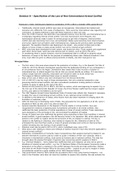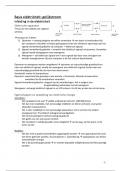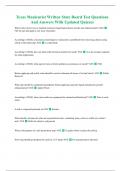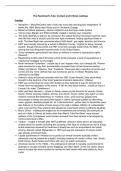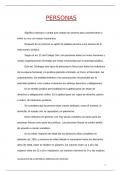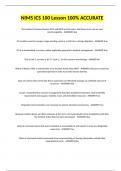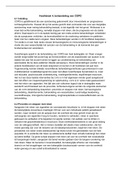Seminar 8 – Specificities of the Law of Non-International Armed Conflict
Prosecutor v Tadić, Interlocutory Appeal on Jurisdiction, IT-94-1-AR72, 2 October 1995, paras 96-137
Traditionally, internal armed conflicts were seen as insurgencies. International law treated such
scenarios very differently from cases of belligerency. There were few international rules regarding civil
commotion, as States preferred to deal with these instances in their own way.
Since the 1930’s however, this distinction has gradually become more blurred, and international law is
increasingly regulating internal armed conflict. Civil wars had become more frequent, and
technological advances made it easier for armed groups to get hold of weapons. Internal armed
conflict were also becoming more cruel, and protracted. States were becoming more interconnected,
and human rights more prevalent under international law, replacing the previous state sovereignty
approach. The question therefore was beginning to be raised – why protect civilians and civilian
objects in times of state on state armed conflict, but not for internal armed conflicts?
NIAC rules have been developed by both custom, and treaty law since. These support and supplement
each other. Some treaty rules have also become part of custom, such as CA3 to the GC’s.
In considering what is custom however, must be remembered that it is difficult to pinpoint actual
behaviour of troops in the field for the purpose of establishing these rules. Reliance therefore in this
area, must often be given to official pronouncements of States, and their manuals for war.
Principal Rules
The first rules in this area where aimed at the protection of civilians. E.g. in the Spanish Civil War of
1936-39, UK Prime Minister Chamberlain asserted that the deliberate bombing of non-combatants in
all circumstances had to be illegal. Chamberlain later stated that it also must be a violation of
international law, to attack targets from the air that you cannot identify as military. If it was clear a
military target had been selected, reasonable care should be taken to avoid civilian loss
The League of Nations reaffirmed these views on several occasions.
Many of the rules of NIAC’s also were developed from the Second World War.
CA3 of 1949 GC’s was the result of these developments. Not only contained substantive rules
governing internal armed conflicts, but also a procedural mechanism inviting parties to internal
conflicts to agree to abide by the rest of the GC’s.
Parties not only bound by GC3 in NIAC’s, but also by custom, which was beginning to expand. E.g. in
the Civil war of the Democratic Republic of Congo, the Prime Minister reaffirmed the Congo’s respect
for IHL, and called on the Rebels to do the same.
The 1967 Nigerian Armed Forces Operational Code of Conduct also reflects this. Deemed it necessary
to apply the rules of international armed conflicts, to any national armed conflicts also.
In addition to the behaviour of States, other factors have also been important in bringing about the
formation of customary rules.
ICRC has been key to developing rules of NIAC. Has advocated for the applications of all IHL rules in
situations of NIAC as well, and if not, then at least CA3
General Assembly Resolutions on the Respect of Human Rights in Armed Conflict, have also
recognised the necessity of applying basic humanitarian principles in all armed conflicts. Also
reaffirmed the basic protection of civilian populations in times of armed conflicts. These resolutions
were declaratory of the principles of CIL, and promoted the adoption of treaties
Groups of States have also reaffirmed the general rules protecting civilians from hostilities in internal
armed conflicts. A good example is the UN Security Council in its resolution 788, which called upon all
parties to the conflict to respect strictly the provisions of IHL (in relation to Liberia). The EU, in
relation to the fighting in Chechnya, also insisted on respect for IHL. Reference of both to ‘IHL’
articulated the view that there exists a corpus of general principles and norms on internal armed
conflict including CA3, but having a much greater scope
Attention must also be paid to AP2 to GC’s, which crystallised many rules of CIL.
What about rules relating to means and methods of warfare however? Have they become applicable to
internal armed conflicts?
Elementary considerations of humanity make it preposterous that weapons banned by States for use
between themselves could be used by a Sate to quash a rebellion of their own nationals. What is
inhumane in international conflicts, must surely be humane also in national conflicts. This idea has
brought about the gradual formation of general rules concerning specific weapons in NIAC’s
E.g. Chemical Weapons – many States have reaffirmed that such weapons can also not be used in
situations of internal armed conflict - e.g. the 12 Members States of the European Community made a
declaration to the effect in relations to the conflict between the Kurds and Iraqi Authorities. Position
also taken by the British Foreign Office for the same conflict – argued to use such a weapon in these
circumstances would be a grace violation of the 1925 Geneva Protocol.
Iraqi government however, flatly denied the accusations that it was using chemical weapons – not
clear to the Chamber (who does not have the mandate to explore this) whether this was actually the
, Seminar 8
case. But indisputably was a consensus in the international community on the principle that the use of
those weapons was also prohibited in NIAC’s.
Rules on NIAC’s have therefore developed in both the context of internal armed conflict, and means
and methods of warfare. Must be remembered however, that only a number of rules of IAC’s have
been held to govern internal armed conflicts, and that this extension has not taken place in the form
of a full and mechanical transplant of rules from one to the other. CIL has been very important in this
area however.
Individual Criminal Responsibility in NIAC’s
Even if some principles apply to both IAC’S and NIAC’s because of custom, does not mean that
breaches in internal armed conflicts give rise to individual criminal responsibility. These provisions
therefore do not fall within the scope of this tribunals jurisdiction automatically.
CA3 contains no explicit reference to criminal liability for violation of its provisions. Nuremberg
however, ruled that a lack of mention of liability for internal conflict breaches in statute of the court
did not prevent them punishing it. Believed this was important to uphold international law
Applying this approach here, no doubt that violations will give rise to individual criminal
responsibility, regardless of whether committed in internal, or international armed conflict..
State practice shows States intend to criminalize serious breaches of CIL in internal armed conflicts
– e.g. Nigerian Code (mentioned above)
Many countries, such as Germany and New Zealand, in their military codes leave no doubt that
breaches of CA3 will also lead to liability in times of internal armed conflict, and that this can even
be upheld in national courts, as per national law
Opinio juris to the effect that violations of IHL in NIAC’s and IAC’s leads to individual criminal
responsibility are also reaffirmed by the Security Council of the UN. All of this confirms that CIL
imposes criminal liability for serious violations of CA3.
In the light of the intent of the Security Council and the logical and systematic interpretation of
Article 3 as well as customary international law, the Appeals Chamber concludes that, under Article
3, the International Tribunal has jurisdiction over the acts alleged in the indictment, regardless of
whether they occurred within an internal or an international armed conflict. Thus, to the extent that
Appellant's challenge to jurisdiction under Article 3 is based on the nature of the underlying conflict,
the motion must be denied.
S. Sivakumaran, ‘Re-envisaging the International Law of Internal Armed Conflict’ (2011) 22 EJIL 219
Internal armed conflicts represent the vast majority of conflicts today, they give rise to many of the
most horrible atrocities, and yet historically they suffered from a lack of regulation
2 Stage process – First was up to the 1990’s, where there was minimal regulation, until 1949 and the
conclusion of CA3 to the GC’s. From here, to the 1990’s, a broader category of internal armed conflict
was regulated, but had relatively few rules. Since 1990’s things have changed dramatically. Since a
clear corpus of law not exists governing NIAC’s, in an increasingly similar way to IAC’s, and its draws
upon international criminal law, and international human rights law. Has led to an international law of
internal armed conflict
Law of internal armed conflicts had to draw upon ICL and IHRL because States reluctant themselves to
agree treaties limiting their ability to deal with uprisings in their own countries
These bodies of law, IHL, ICL, and IHRL, however, need to be balanced against each other, for they
sometimes conflict and overlap. Further issues arise from taking laws of IAC’s and applying them to
NIAC’s, where armed groups are involved
A step backwards therefore must be taken, to view the law as it currently stands.
Stage 1: Minimal Regulation of Internal Armed Conflict
Traditionally, states have been reluctant to regulate internal armed conflict, because they view it as a
limitation of sovereignty in their internal affairs. Prior to 1949 therefore, little in the way of regulation
for NIAC’s.
Post 1949, until the 1990’s, international law regulated internal armed conflicts at a high threshold
that had to be met, that went well beyond the limited category of recognised insurgency. Only a
minimal number of rules applied as well. This consisted of CA3 to the GC’s, Article 19 of the Hague
Convention for the Protection of Cultural Property 1954, and AP2 to the GC’s.
All were limited in subject matter however, and AP2 was seen as a pared-back version of its full
potential.
CIL was even less clear. Was accepted that some rules existed in relation to NIAC’s, but identification
of these rules was more elusive. Commentators had different views on what provisions of IHL were
part of custom, particularly in relation to AP2. As late as 1994, the Commission of Experts appointed
to investigation violations of IHL in the former Yugoslavia wrote that ‘It is unlikely that there is any

